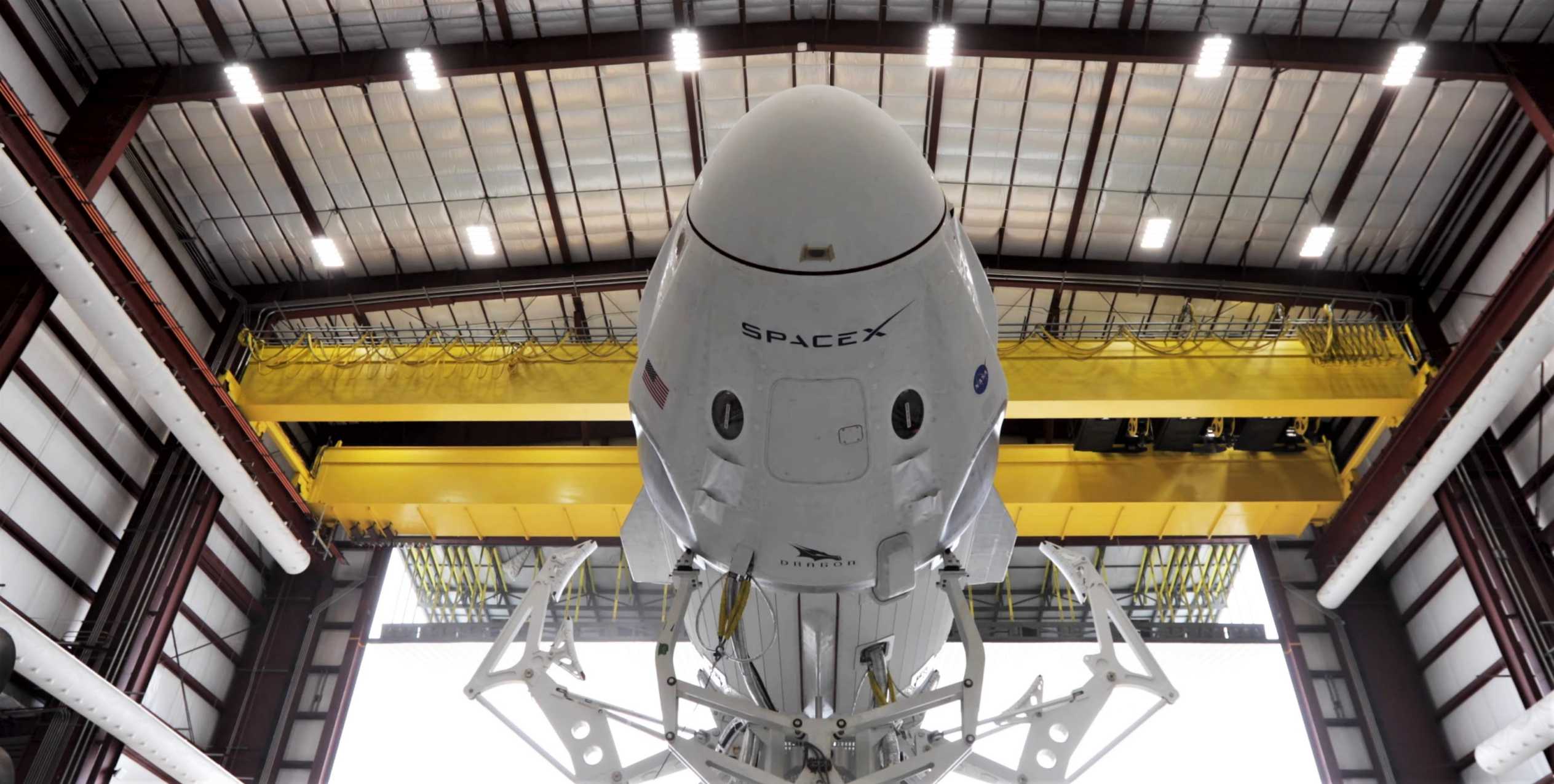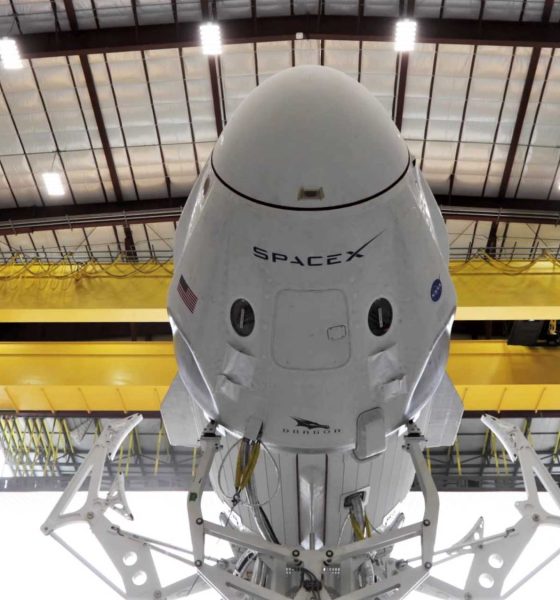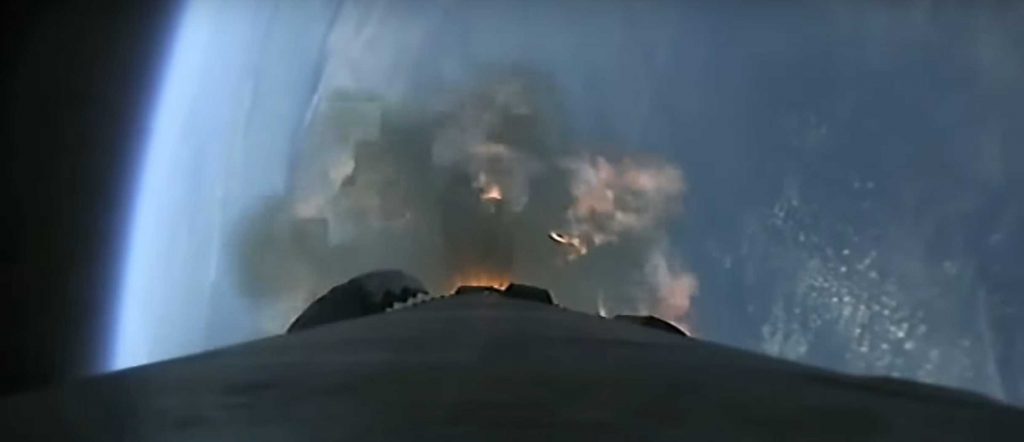

News
SpaceX, NASA hold press conference, historic astronaut launch clears final hurdles before readiness
With less than a month to go before the historic first crewed flight – and final human rating certification test – of the SpaceX Crew Dragon Demonstration 2 mission, NASA and SpaceX jointly held a full day of pre-mission press conferences on Friday, May 1st. Throughout the day many minor, but crucial, details were revealed.
Two primary technical concerns remained prior to Crew Dragon’s debut astronaut mission- the final drop test of the Crew Dragon Mark III parachutes and NASA’s clearance of SpaceX’s resolution of an in-flight engine-out anomaly suffered during the ascent phase of a previous Starlink mission.

Falcon 9 Merlin 1D engine-out anomaly
During the March 18th Starlink launch of a four-time flown Falcon 9 first-stage booster, a brief anomalous engine flare was witnessed during the ascent. Although ultimately successful in the deployment of the stack of 60 satellites, the first-stage booster failed to stick the landing aboard the autonomous spaceport drone ship “Of Course I Still Love You” resulting in a total loss. SpaceX CEO, Elon Musk, responded to comments posted to Twitter confirming the in-flight, early shutdown anomaly of one of the nine Merlin 1D engines.
Musk provided assurance that a thorough investigation would be conducted by SpaceX prior to any return to flight. Musk also noted that the first-ever engine failure of a Merlin 1D engine proved its robustness and the importance of redundancy provided by the other eight engines.
Just prior to the next Starlink mission on April 22nd marking a recycled Falcon 9 booster’s return to flight, Musk once again took to Twitter to provide insight into the early shutdown, in-flight anomaly. Musk stated that a small amount of isopropyl alcohol, used for cleaning the Merlin 1D engines, had been trapped in a sensor dead leg – later clarified as “an area it couldn’t float through” by SpaceX webcast host Lauren Lyons – and was ignited during flight causing the early shutdown of one Merlin 1D engine.
As identified during the April 22nd launch broadcast, out of an abundance of caution SpaceX decided to forgo that cleaning process for the April 22nd mission. However, no information was divulged regarding NASA’s response to either the anomaly or the resolution. Ultimately, the first stage Falcon 9 booster of the Starlink-6 performed flawlessly and even managed to stick the landing aboard the awaiting drone ship.
During Friday’s Commercial Crew and International Space Station overview news conference, a question regarding NASA’s response to the anomaly posed by Jeff Foust – reporter for SpaceNews.com – was directed to NASA’s Commercial Crew Program program manager, Kathy Lueders. She was asked to expand on the final technical constraints remaining prior to the launch of the Crew Dragon DM-2. Lueders responded positively stating that NASA had “reviewed the anomaly resolution…and cleared the engines on our launch vehicle” referring to the Falcon 9 booster slated to support DM-2, noting that the engine-out issue had been satisfactorily resolved and is now behind them.
One more drop test
Early in Friday’s Commercial Crew and International Space Station overview news conference – and later confirmed during remarks made by Lueders – SpaceX Chief Operating Officer, Gwynne Shotwell noted that a final 27th drop test of the Crew Dragon Mk III parachutes was scheduled to be completed later in the day. During a later Q&A interview with the crew of DM-2 – NASA astronauts Bob Behnken and Doug Hurley – Hurley commented that the final drop test had begun, however, he wasn’t quite sure if it had been completed successfully or not.
Just after the closing remarks of the crew Q&A interview, SpaceX announced via social media the successful completion of the 27th and final drop test of the all-important Mk III parachutes.
The May 1st final parachute drop test followed a worrisome stumble of the parachute program on March 24th. SpaceX announced that a Crew Dragon test article had become unstable forcing the helicopter pilot to prematurely release the test article out of an abundance of caution to maintain the safety of the helicopter crew. SpaceX noted that “while the test article was lost, this was not a failure of the parachute system and most importantly no one was injured.”
The confirmation of the successful May 1st drop test and the resolution of the Merlin 1D engine anomaly close out one of the final chapters of prerequisites prior to returning human spaceflight to American soil.
The only hurdles that remain to be cleared are various agency-level readiness reviews. According to Lueders, a SpaceX Flight Readiness Review is tentatively scheduled for Friday, May 8th followed by a NASA Flight Readiness Review on May 11th. Just one week ahead of launch, the final joint Launch Readiness Review is tentatively scheduled to be completed Wednesday, May 20th at which point DM-2 will bring crewed astronaut spaceflight back to American soil for the first time in nearly a decade.
Check out Teslarati’s newsletters for prompt updates, on-the-ground perspectives, and unique glimpses of SpaceX’s rocket launch and recovery processes.

Elon Musk
Elon Musk and Tesla AI Director share insights after empty driver seat Robotaxi rides
The executives’ unoccupied tests hint at the rapid progress of Tesla’s unsupervised Robotaxi efforts.

Tesla CEO Elon Musk and AI Director Ashok Elluswamy celebrated Christmas Eve by sharing personal experiences with Robotaxi vehicles that had no safety monitor or occupant in the driver’s seat. Musk described the system’s “perfect driving” around Austin, while Elluswamy posted video from the back seat, calling it “an amazing experience.”
The executives’ unoccupied tests hint at the rapid progress of Tesla’s unsupervised Robotaxi efforts.
Elon and Ashok’s firsthand Robotaxi insights
Prior to Musk and the Tesla AI Director’s posts, sightings of unmanned Teslas navigating public roads were widely shared on social media. One such vehicle was spotted in Austin, Texas, which Elon Musk acknowleged by stating that “Testing is underway with no occupants in the car.”
Based on his Christmas Eve post, Musk seemed to have tested an unmanned Tesla himself. “A Tesla with no safety monitor in the car and me sitting in the passenger seat took me all around Austin on Sunday with perfect driving,” Musk wrote in his post.
Elluswamy responded with a 2-minute video showing himself in the rear of an unmanned Tesla. The video featured the vehicle’s empty front seats, as well as its smooth handling through real-world traffic. He captioned his video with the words, “It’s an amazing experience!”
Towards Unsupervised operations
During an xAI Hackathon earlier this month, Elon Musk mentioned that Tesla owed be removing Safety Monitors from its Robotaxis in Austin in just three weeks. “Unsupervised is pretty much solved at this point. So there will be Tesla Robotaxis operating in Austin with no one in them. Not even anyone in the passenger seat in about three weeks,” he said. Musk echoed similar estimates at the 2025 Annual Shareholder Meeting and the Q3 2025 earnings call.
Considering the insights that were posted Musk and Elluswamy, it does appear that Tesla is working hard towards operating its Robotaxis with no safety monitors. This is quite impressive considering that the service was launched just earlier this year.
Elon Musk
Starlink passes 9 million active customers just weeks after hitting 8 million
The milestone highlights the accelerating growth of Starlink, which has now been adding over 20,000 new users per day.

SpaceX’s Starlink satellite internet service has continued its rapid global expansion, surpassing 9 million active customers just weeks after crossing the 8 million mark.
The milestone highlights the accelerating growth of Starlink, which has now been adding over 20,000 new users per day.
9 million customers
In a post on X, SpaceX stated that Starlink now serves over 9 million active users across 155 countries, territories, and markets. The company reached 8 million customers in early November, meaning it added roughly 1 million subscribers in under seven weeks, or about 21,275 new users on average per day.
“Starlink is connecting more than 9M active customers with high-speed internet across 155 countries, territories, and many other markets,” Starlink wrote in a post on its official X account. SpaceX President Gwynne Shotwell also celebrated the milestone on X. “A huge thank you to all of our customers and congrats to the Starlink team for such an incredible product,” she wrote.
That growth rate reflects both rising demand for broadband in underserved regions and Starlink’s expanding satellite constellation, which now includes more than 9,000 low-Earth-orbit satellites designed to deliver high-speed, low-latency internet worldwide.
Starlink’s momentum
Starlink’s momentum has been building up. SpaceX reported 4.6 million Starlink customers in December 2024, followed by 7 million by August 2025, and 8 million customers in November. Independent data also suggests Starlink usage is rising sharply, with Cloudflare reporting that global web traffic from Starlink users more than doubled in 2025, as noted in an Insider report.
Starlink’s momentum is increasingly tied to SpaceX’s broader financial outlook. Elon Musk has said the satellite network is “by far” the company’s largest revenue driver, and reports suggest SpaceX may be positioning itself for an initial public offering as soon as next year, with valuations estimated as high as $1.5 trillion. Musk has also suggested in the past that Starlink could have its own IPO in the future.
News
NVIDIA Director of Robotics: Tesla FSD v14 is the first AI to pass the “Physical Turing Test”
After testing FSD v14, Fan stated that his experience with FSD felt magical at first, but it soon started to feel like a routine.

NVIDIA Director of Robotics Jim Fan has praised Tesla’s Full Self-Driving (Supervised) v14 as the first AI to pass what he described as a “Physical Turing Test.”
After testing FSD v14, Fan stated that his experience with FSD felt magical at first, but it soon started to feel like a routine. And just like smartphones today, removing it now would “actively hurt.”
Jim Fan’s hands-on FSD v14 impressions
Fan, a leading researcher in embodied AI who is currently solving Physical AI at NVIDIA and spearheading the company’s Project GR00T initiative, noted that he actually was late to the Tesla game. He was, however, one of the first to try out FSD v14.
“I was very late to own a Tesla but among the earliest to try out FSD v14. It’s perhaps the first time I experience an AI that passes the Physical Turing Test: after a long day at work, you press a button, lay back, and couldn’t tell if a neural net or a human drove you home,” Fan wrote in a post on X.
Fan added: “Despite knowing exactly how robot learning works, I still find it magical watching the steering wheel turn by itself. First it feels surreal, next it becomes routine. Then, like the smartphone, taking it away actively hurts. This is how humanity gets rewired and glued to god-like technologies.”
The Physical Turing Test
The original Turing Test was conceived by Alan Turing in 1950, and it was aimed at determining if a machine could exhibit behavior that is equivalent to or indistinguishable from a human. By focusing on text-based conversations, the original Turing Test set a high bar for natural language processing and machine learning.
This test has been passed by today’s large language models. However, the capability to converse in a humanlike manner is a completely different challenge from performing real-world problem-solving or physical interactions. Thus, Fan introduced the Physical Turing Test, which challenges AI systems to demonstrate intelligence through physical actions.
Based on Fan’s comments, Tesla has demonstrated these intelligent physical actions with FSD v14. Elon Musk agreed with the NVIDIA executive, stating in a post on X that with FSD v14, “you can sense the sentience maturing.” Musk also praised Tesla AI, calling it the best “real-world AI” today.








